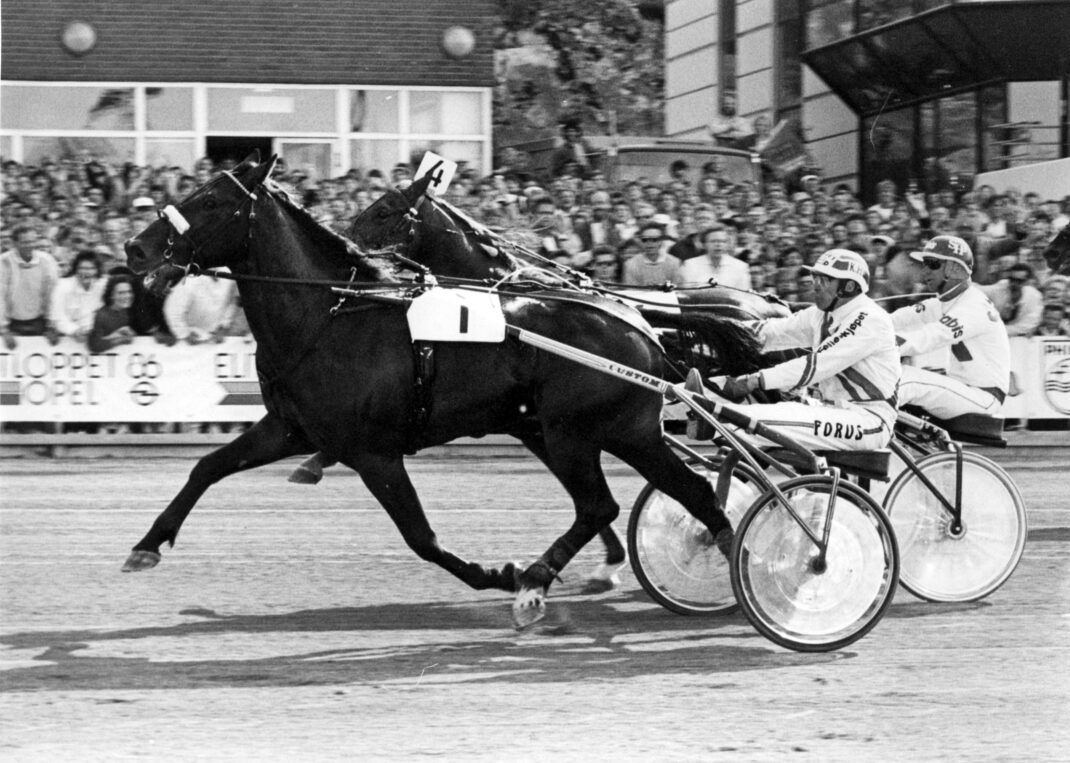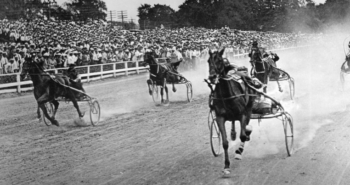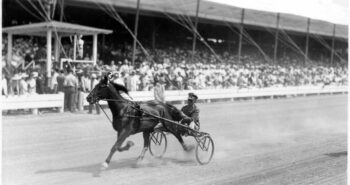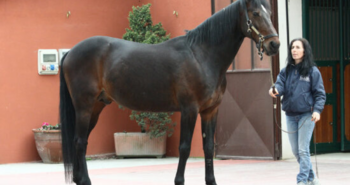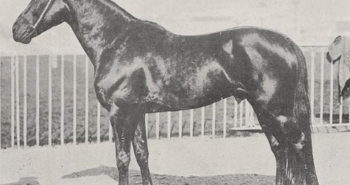Throughout history there have been a few select horses that have singlehandedly increased the interest in harness racing and drawn people to the tracks like never before. One of the most important such horses is Rex Rodney, the Norwegian rags-to-riches story who started his career without a victory at 3 but ended up winning one of the world’s biggest races. A horse with no apparent pedigree to talk of and who did not even break the 2:00 (1.14,6) barrier until he was 6 years old, he eventually became a household name all over Norway and Scandinavia.
In fact, when the colt was 5, if anybody had even suggested that Rex Rodney would start in the Elitlopp the following year they would probably be laughed at for a long time. The son of Doctor Rodney was a late bloomer – an exceptionally late boomer in fact. Nine starts as a 3-year-old saw him winless and a fastest time of 1.22,6 (2:13f) and 16,805 NOK, less than $2,000, in earnings. He was slow to leave and had to go around horses toward the end, something he didn’t quite have the ability to do at that point. People around him saw some talent but could not possibly predict what was to come a few years later. As a 4-year-old the colt starting winning, going 6-4-3 in 21 starts, a personal best of 1.20,6 (2:09.3f) and earnings of 63,000 NOK, less than $8,000 USD, meant he was still way off the top of his crop in his native Norway. But something was happening. Rex Rodney finished the season strong and was 4-2-2 in his last 10 starts at 4. What was a coarse and immature youngster was growing into a refined and mature individual.
And then the wins started pouring in. As a 5-year old he won 25 of 35 starts and he lowered his record to 1.15,7 (2:01.4f) – a relatively fast time in Norway at that time. Not only that, while he couldn’t leave very fast early in his career, by this time he had developed a devastating gate speed. But, he still had not gone up against the best even in his home country. In Northern Europe it is common for horses to compete in a divisional system, except for age-specific or invitational races, and the divisions are based on career earnings. Despite having a great 5-year season, Rex Rodney was still a silver division horse with career earnings of 313,000 NOK, less than $40,000 and not everybody was convinced he was had what it takes to continue his winning ways in the gold division, which is the elite level.
A surprising breakthrough
In 1986, however, Forus Open, a new European Grand Circuit race, was instituted at Forus, Rex Rodney’s hometrack near Stavanger, Norway. Had it been at a bigger track it is doubtful whether Rex Rodney would even have been invited but the colt started as one of three local hopefuls. Though he had 14 straight wins he was completely untested at the highest level. The opposition was tough with opponents such as Quiggin, Matine and Lea Key, winner of several big Swedish races. In addition Bo W Takter, Jimmy’s father, brought his star Ellizar H, the previous year’s winner of the Nordic Championship, to Forus. Before the race, Rex Rodney’s trainer Kjell Håkonsen stated that “looking at these opponents there is no shame in finishing last.” When Rex Rodney ended up parked outside of the leading Lea Key it seemed a hopeless task for a rookie at the highest level. At the backstretch, however, Rex Rodney forced the tempo and took the lead going into the final turn, never looking back and in the end winning by 3 lengths in 1.14,3 (1:59.3f), lowering his absolute record by more than 2 seconds. This was the first time the trotter broke the 2:00 barrier.
Racing against the the Norwegian elite the next weekend in Drammen, winning comfortably in 1.14,9 (2:00.3h), it was immediately clear that Rex Rodney was new the aged star in Norway. This set the stage for a showdown with Utah Bulwark, Ellizar H and Super Play in the country’s biggest race for aged trotters, Oslo Grand Prix, one month later. With Rex Rodney winning that, too, he had doubled his earnings in just five weeks and the Elitlopp hosts were quick to issue an invitation.
The Elitlopp
Håkonsen almost snubbed the invitation, however, claiming that unless the Swedish hosts provided his his star with air travel to Solvalla there were plenty of interesting races in Norway to focus on instead. Of course this was an outrageous white lie: no race in Scandinavia was, or is, comparable to the Elitlopp and there certainly was nothing even remotely close in Norway. In fact, the closest thing would be the Oslo Grand Prix, a race he had just won. But Solvalla really wanted the Norwegian star and arranged for a plane. Going to Solvalla, Rex Rodney stood at 18 consecutive wins and after easily winning his elimination in 1.12,6 (1:56.4f) in impressive fashion he was made the favorite in the final ahead of Stig-H Johansson’s Utah Bulwark, who had lost his elimination heat to Super Play, the US-born son of Super Bowl and Panama.
In the final Rex Rodney was surprised from the get-go. Emile, a massive horse well over 17 hands (170 cms), who towered over the comparatively tiny Rex Rodney, measuring 15,3 hands (160 cms), had exceptional gate speed and easily overtook the Norwegian trotter leaving from post 1. Into the first turn, Diva Lill sat right behind Rex Rodney and Kjell Håkonsen suddenly had a massive dilemma on his hands: Emile and Diva Lill were both from Stig H Johansson’s stable while Utah Bulwark, Stig H’s third horse in the race, was already on his way forward three-wide. If Håkonsen chose cover behind Emile then he would be boxed in with Stig H’s horses holding all the aces. But going first over seemed like an even tougher proposition. Emile was a strong horse and Utah Bulwark, driven by Stig H himself, was an exceptionally strong trotter who had no problems going third over the whole race if necessary. Håkonsen chose the lesser evil, namely parking his star outside Emile. Despite the odds being against him, Rex Rodney put pressure on Emile in the backstretch and wore him down early in the final stretch, then held off Utah Bulwark, who had gone most of the race third over, to claim Norway’s first ever Elitlopp win.
When commenting on the race years later Stig H Johansson said he didn’t really mind losing to Håkonsen and Rex Rodney, describing his Norwegian counterpart as a really good professional and a true horseman that he had lot of respect for. Håkonsen was widely considered the top trainer in Norway, constantly producing new stars from his small stable in the southwest part of the country, and was also known for turning around the fortunes of horses who struggled elsewhere. He stressed the basics and most trotters in his stable got intimately familiar with pulling tractor wheels on slow walks through the nearby forest, getting the necessary strength and foundation in place before upping the speed. Håkonsen was a perfectionist in every way but was equally known for his dry humor, witty remarks and a relatively stoic approach. Once, when asked by a journalist about his relationship status Håkonsen replied he was married. When the journalist asked to whom, Håkonsen replied “oh, to a woman you see. Like most guys over here”. In an even more famous story, Håkonsen’s horse transport had broken down close to the Bjerke racetrack in Oslo during rush-hour. Behind him was an impatient driver who kept honking his horn. Håkonsen got out of the trailer, walked calmly over to the impatient driver and knocked on the window. “Listen, why don’t we do it this way instead: I’ll sit in your car and honk the horn while you try to start my transport.”
However, winning streaks often end when one least expects it. In the race following the Elitlopp win, Rex Rodney surprisingly lost to Florican Will in Bergen. Later that summer Rex Rodney lost two races, both to Habib, winner of the 1986 International Trot, but otherwise stayed undefeated. He thus ended the year as 23-1-1 in 26 starts. With only two starts abroad it’s difficult to claim he was the best aged trotter in Europe over shorter distances that year, but Rex Rodney would surely be among the top five in such a ranking.
Disqualified
The 1987 season started much like the previous year, with wins in both Forus Open and Oslo Grand Prix. Back at Solvalla he won his elimination before disaster struck in the final. While battling Grades Singing for the lead as the car left, Rex Rodney uncharacteristically made a wild break. Then Rex Rodney also showed his immense abilities, maybe more than ever. Spotting the field around 30 lengths out, Håkonsen had failed to hear the colt was disqualified. Rex Rodney shocked everybody when the caught up to the field very quickly, a half he ran far below the world record tempo, but as the trainer-driver finally heard the disqualification announced he pulled Rex Rodney out of the race. Some spectators felt he could have won even with the massive break.
Later that year followed an unsuccessful trip to the International Trot, where Rex Rodney made a break. Håkonsen later stated that the track, with lack of banked curves, was completely unsuited to his elite trotter. In 1988 Mack Lobell and Sugarcane Hanover came to Europe and the former king had to play second fiddle in the biggest races. But in Norway he was otherwise the top horse although injuries plagued him a bit in later years. At 10, however, he was almost as good as ever and won both the Forus Open, a race he won a record four times, and the Norwegian championship.
Rex Rodney finished his career 108-20-10 in 179 starts, though from 5 and onwards he was 104-15-6 in 149 starts. Although his personal best was “only” 1.12,4 (1:56.2f), Håkonsen later expressed a firm belief his star pupil was capable of around 1.10 (1:52-1:53) on a fast track. Rex Rodney showed exceptional short speed, most notably in the 1987 Drammen Grand Prix where his whirlwind finish was clocked by some at 12 seconds for the 200 meter (one-eight) final stretch, a speed burst impressive even by today’s standard.
An oddball pedigree
Anybody looking at Rex Rodney’s pedigree usually stares in disbelief, wondering where the good genes come from. His sire, Doctor Rodney, was a well-bred horse who, after a lot of early problems, became a top trotter for Håkan Wallner in Sweden. At stud, however, he failed to produce any stars other than Rex Rodney despite several hundred foals, virtually all of his few good ones being late bloomers. Rex Rodney’s dam, the Danish-born Nulle Hanover, was a good trotter with 21 wins in 108 starts but from six foals she only produced two winners – the other being Nelly Moser 1.24,5 (2:16f). Nulle Hanover’s pedigree was also highly average. Her sire Lance Hanover was no star on the track although he had been a decent stallion in Denmark. The maternal side appears predominantly Danish but it goes back to California through Lizette Dillon, imported to Denmark, whose dam Miss Lizzie S is a sister to Bingen. There is quality in other branches of this maternal family (including Beach Towel, We Will See and Magical Mike, interestingly all pacers) but the branch through Lizette Dillon is quite limited.
Rex Rodney had 94 foals but was a massive disappointment at stud. Still, the bay colt is the one horse credited with popularizing trotting in Norway during the 80s and had a massive impact on the interest in the sport. Absolutely everybody recognized his name and especially his trademark waiving the tail in the final stretch.
The owner decided to euthanize the colt at 15 as he had fallen completely out of favor at stud, a decision which caused controversy and outrage in Norway. Trainer Kjell Håkonsen was one of many who harshly criticized the decision and expressed a wish he had been given the chance to take care of his former star for the rest of his lifetime.
Rex rodney
Bay colt born Feb 21, 1980 in Rogaland, Norway. Died Jan 12, 1995 in Stavanger, Norway.
Doctor Rodney – Nulle Hanover (Lance Hanover)
179 starts: 108-20-10 – Fastest win: 1.12,6 (1:56.4f) – Fastest time: 1.12,4 (1:56.2f) – 5,830,559 NOK
Breeder: Torleif Thu
Owner: Torleif Thu
Trainer: Kjell Håkonsen
Drivers: Kjell Håkonsen, Svend Hansen, Kjell Sele, Magnus Helland, Gunnar Mehla, Lars B Revheim, Hans Petter Tholfsen
Groom: –

